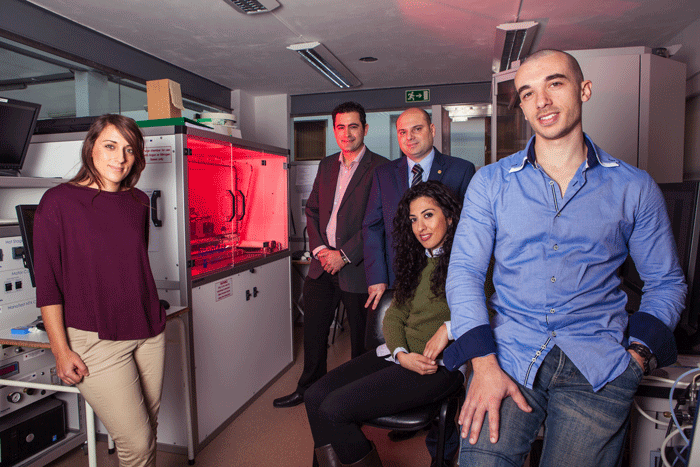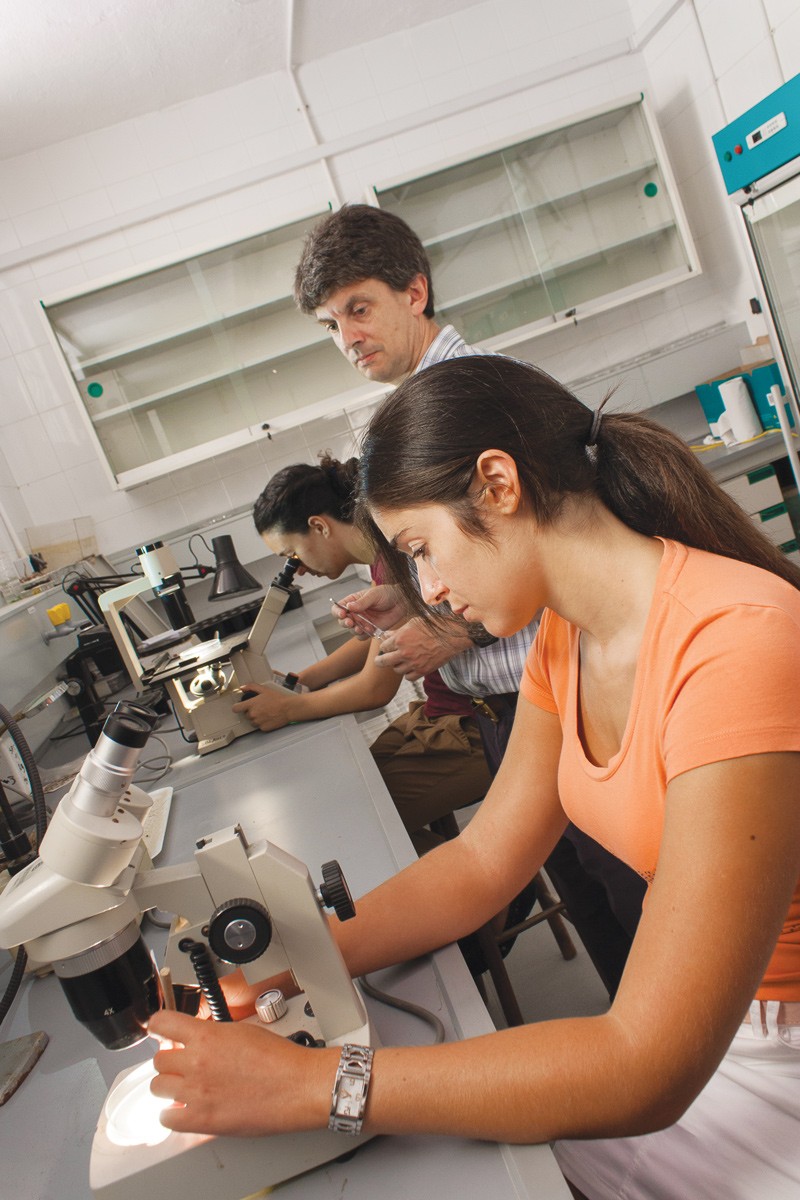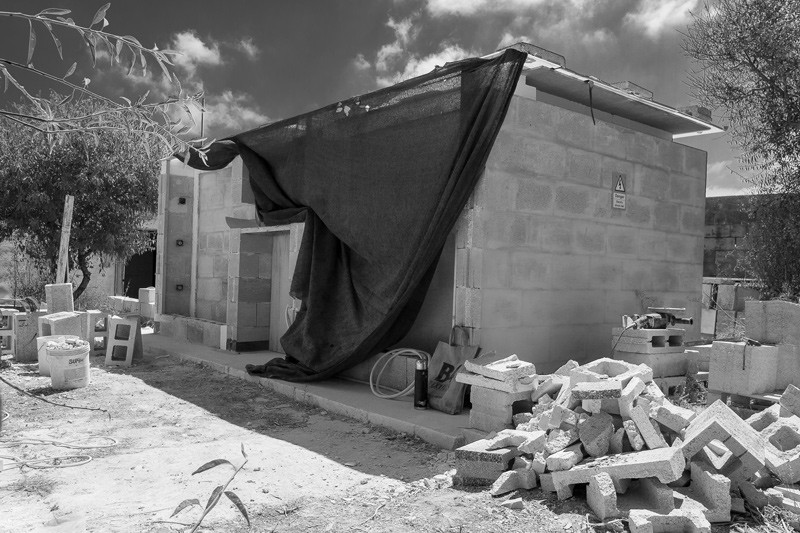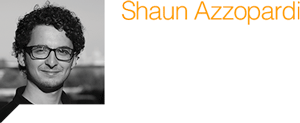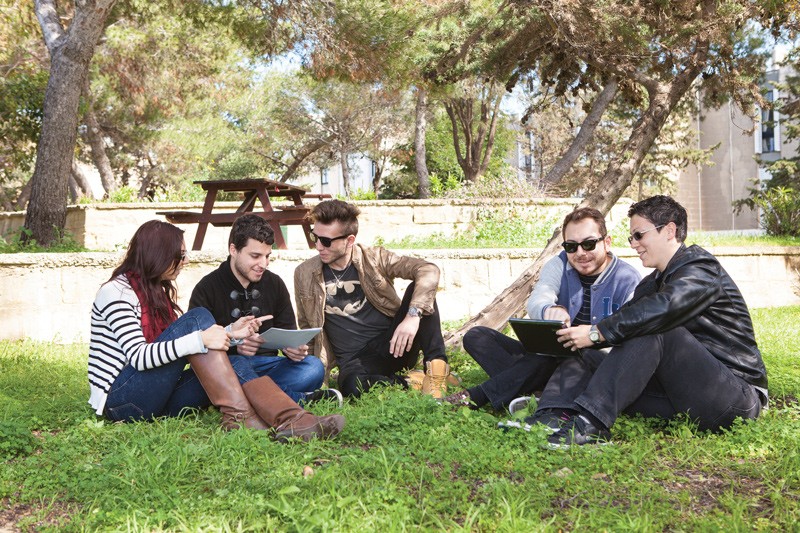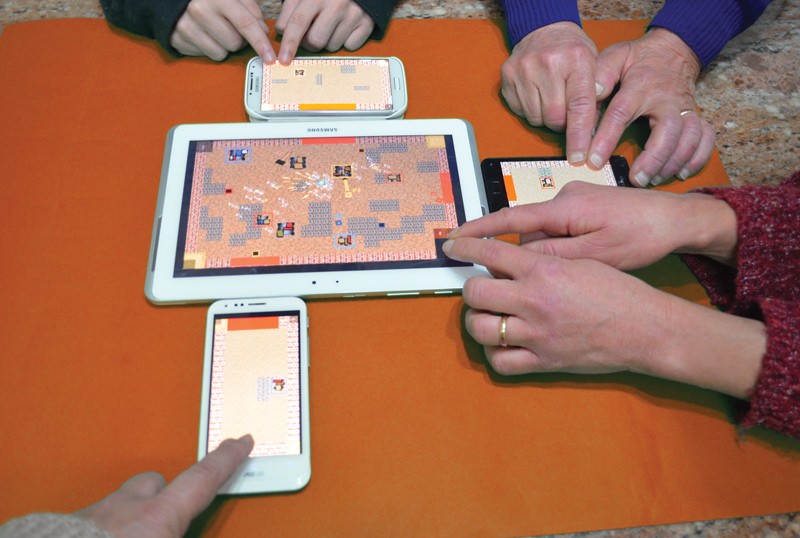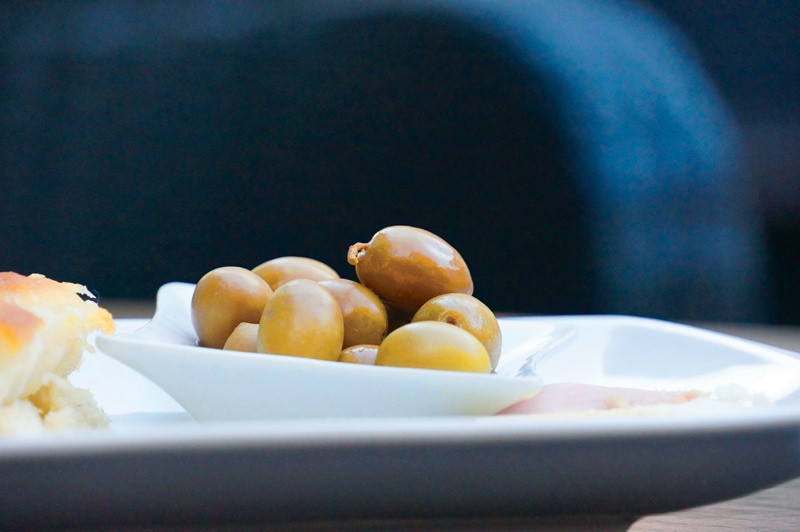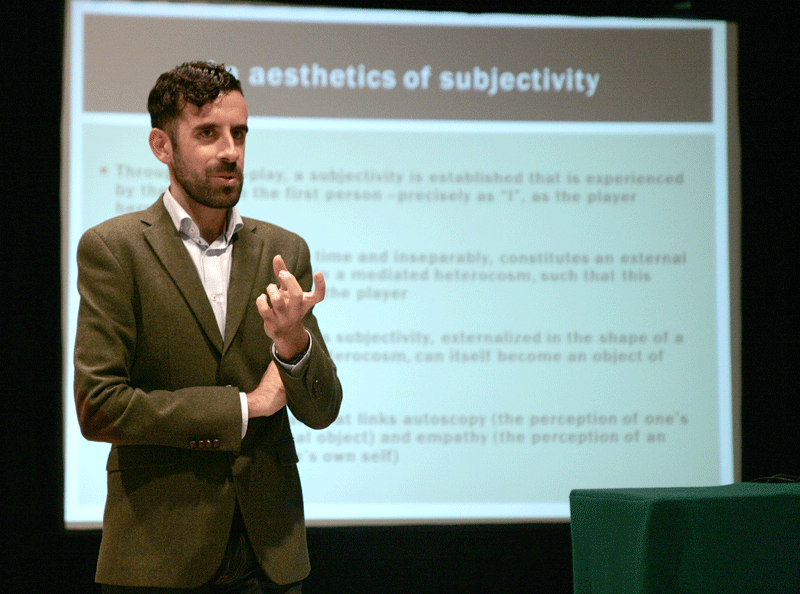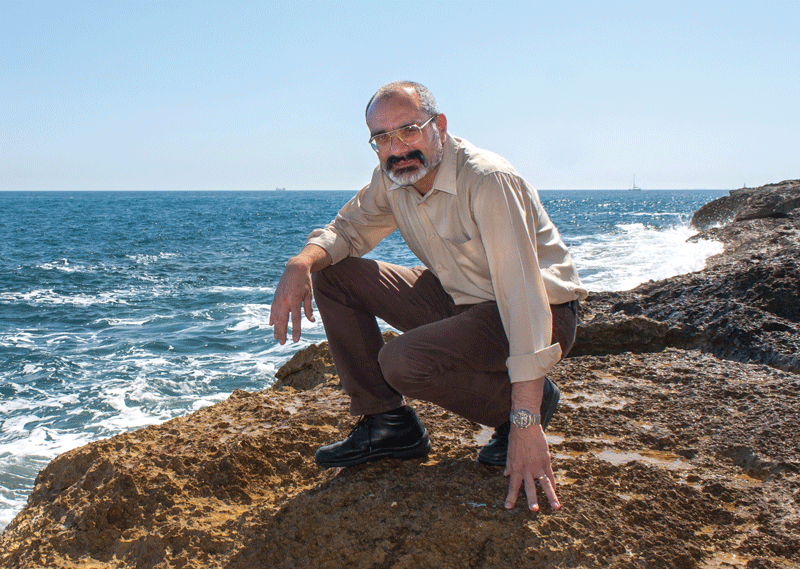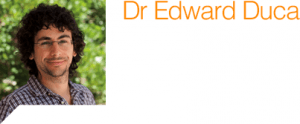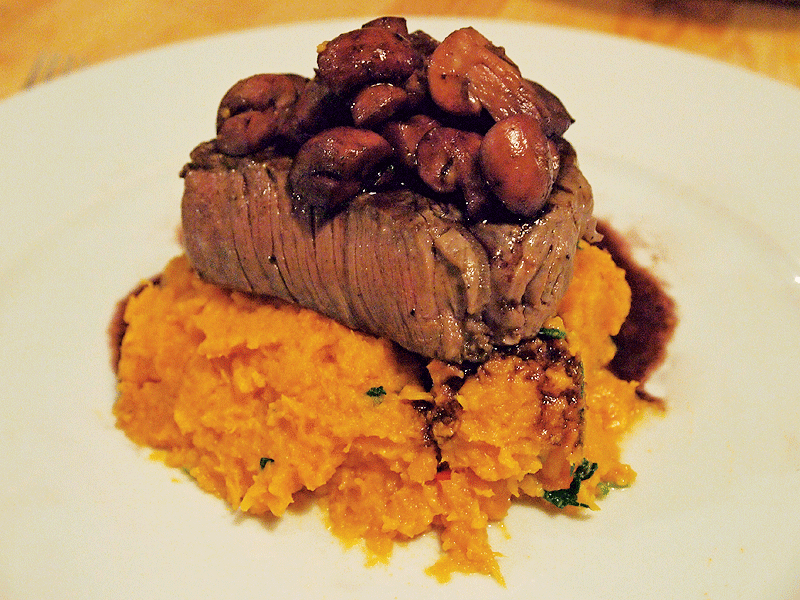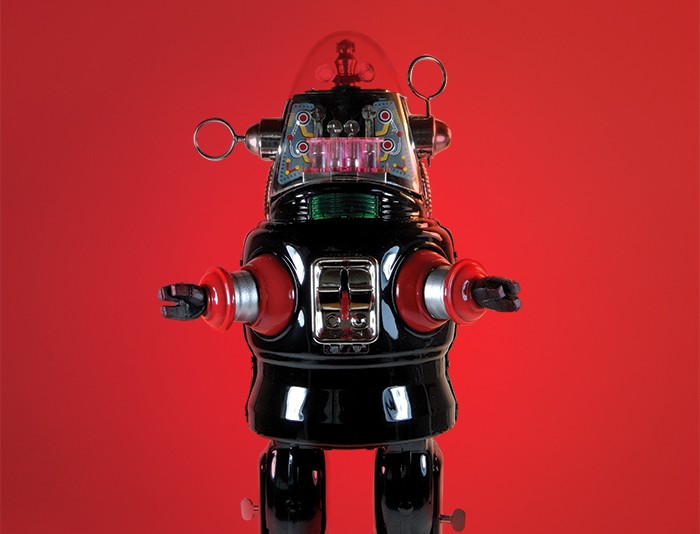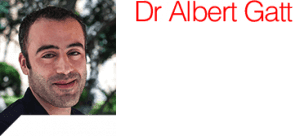The Pool Party: Life at the Extreme
Shrimps, water fleas, waterworts, and pondweeds, this is one wild party. Dry summers with temperatures of over 40 degrees in summer and flooded winters, life in a rockpool is not easy. Decades of research by local ecologists have shed light on this extreme habitat—Dr Sandro Lanfranco, Kelly Briffa, and Sheryl Sammut tell us more.Continue reading
Hot House, Bad House
Shaun Azzopardi met up with a team of researchers led by Eur. Ing. Charles Yousif to take the concrete block to the next level. It is more exciting than it sounds. Photography by Dr Edward Duca.Continue reading
Social Wellbeing Policy at University?
University can be incredibly stressful. Staff perform high level work with plenty of academic responsibilities, while balancing a private life and leisure time. The number of students at University is rising every year. For academic and support staff this means a more intensive workload, pressure, and stress. For students it is the pressure of attaining good results, maintaining relationships, and other social and emotional wellbeing issues, such as coping with peer pressure, struggling with deadlines, and worries about the future. Numerous studies suggest that examinations negatively impact on student health and wellbeing. Some coping strategies and time management programmes have evolved at the University of Malta, for example by the University Chaplaincy. Such well-meaning initiatives are good and do good, but tend to happen sporadically and around examination time.
Many University of Malta students balance multiple identities. They often fall outside the typical demographic of an 18-year-old sixth form school leaver. Our students come from diverse socio-economic backgrounds, and may be studying full-time or part-time, with a variety of life roles: mature students, women with care responsibilities, persons challenged by disability or facing problems due to sexual orientation. Whatever the situation in life, each diverse identity places increased demands upon the students’ time and private life. These demands influence their University experiences, study perceptions, and learning style. Their peers might treat them differently due to their background.
“A social wellbeing policy will help foster confidence in its approach to academic learning, and to eliminate discrimination in favour of a more inclusive learning environment”
Besides worries about assignment deadlines and writing exams, many students are also in employment. I am not sure this trend is in line with University of Malta regulations, nevertheless, that is the situation. Students also worry about future prospects with no guarantee of secure employment after finishing their studies. So it is not only academic concerns that come in the way of student social wellbeing, and these may lead to high levels of stress, anxiety or frustration, depressed mood, difficulties with time management, procrastination, poor concentration, withdrawal from friends or family, or physical symptoms such as headaches, sleep problems, and exhaustion. University life presents numerous stress factors that may trigger off mental health difficulties.
Students experiencing stress are normally recommended psychological intervention and counselling, which may be beneficial for extremely stressed students. However, research suggests that physical activity helps improve mental health and wellbeing. The University of Malta, through its Work Resources Fund, promotes cycling through the Green Travel Plan. The initiative is more about sustainability and the environment, apart from a solution to the parking problem. However, cycling does improve our mental health and wellbeing, and is a free personal de-stressor by taking our mind off work or study, and leads to healthier lifestyle choices. 
A social wellbeing policy for University will help foster confidence in its approach to academic learning, and to eliminate discrimination in favour of a more inclusive learning environment. Indeed, the principles of equality and diversity such as gender or disability are essential for a true understanding of social wellbeing, and these same principles need to be included in our University’s policy document and implemented in practice. Diversity in a dynamic, intellectual environment enriches professional and educational experiences for both staff and students.
Diversity on campus is needed and important for a healthy University. Internationally, social wellbeing on campus is being promoted through an organisational structure embedded into the ethos, culture, policies, and daily practices of a university. A social wellbeing policy includes an improved occupational health and safety system, and a commitment to address mental wellbeing, physical inactivity, unhealthy eating and substance misuse. The University needs constant commitment to positively influence the life and work of all staff and students.
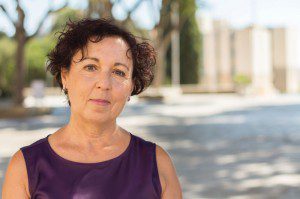
The University is encouraged to guard the integrity of its communication system. Collaboration and open communication fosters conversations and relationships necessary to bring about social wellbeing. The communication process needs to be trusted and confidential for team spirit and social wellbeing. For instance, I would strongly argue for an email policy that discourages unnecessary use of bcc in emails, as the practice of not telling the original addressee is unethical and downright deceitful.
The University of Malta could establish itself as a national contact point on the European Network for Health Promoting Universities (see www.eurohpu.aau.dk). It would commit the University to place social wellbeing high on its policy agenda. A working document published by the World Health Organisation Regional Office for Europe provides guidance on how to set up and develop a health-promoting university project, which would enhance and protect the social wellbeing of all staff and students.
Finally, I would also suggest an exploratory research study about aspects of university life, stress factors in teaching and learning activities, and how these impact on individual experiences. The aim is to understand the general quality of life, and how this can be improved for an informed social wellbeing policy document at the University of Malta.
This article is based on a paper Camilleri-Cassar presented at a seminar organised by the Faculty for Social Wellbeing in October 2013.
Read more here:
– Carroll, A. (2011) ‘Exploring the link between equality, diversity and wellbeing.’ In Marshall, L. and Morris, C. (eds) Taking Wellbeing Forward in higher education: reflections on theory and practice, University of Brighton Press.
– Hagarthy, D. and Currie, J. (2012) ‘The Exercise Class Experience: an opportunity to promote student wellbeing during the HSC’, Journal of Student Wellbeing, vol. 5(2):1-17.
– Hall, C., Ramm, J. and Jeffery, A. (2011) ‘Developing the University of Brighton as a Health Promoting University: the story so far.’ In Marshall, L. and Morris, C. (eds) Taking Wellbeing Forward in higher education: reflections on theory and practice, University of Brighton Press.
– UniHealth 2020: Mission Statement, www.eurohpu.aau.dk
An Automatically Tailored Experience
Digital games need to keep players engaged. Since games are interactive media, achieving this goal means that game designers need to anticipate player actions to create a pre-designed experience. Traditionally, developers have achieved this by restricting player freedom to a strict set of actions thereby curating player experience and ensuring the fun factor. However, games are taking a different route with more users making their own content (User Generated Content, UGC) through extensive creativity tools which make it hard to predict player experience.
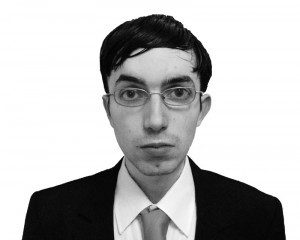
To overcome these challenges Vincent E. Farrugia (supervised by Prof. Georgios N. Yannakakis), merged game design and artificial intelligence (AI). He developed a software framework for handling player engagement in environments which feature user generated content and groups. The three pronged solution tackles problems during game production, playing the game itself, and making sure the framework is sustainable. To maintain engagement within groups he analysed data for a particular person within the group but also patterns common across the whole group. Farrugia created software tools, autonomous AI aids, and tools to test and support the framework.
The software framework is made up of inter-operating modules. Firstly, an engagement policy module allows designers to specify theories to express their vision of positive game engagement. Player modelling then shapes this backbone to specific player engagement needs. The module can autonomously learn from player creations as reactions to game stimuli. Individual and group manager modules use this mixture of expert knowledge, AI learnt data, and player game-play history to automatically adapt game content to solve player engagement problems. This procedural content generation (PCG) is tailored for a specific player and time.
The framework’s abilities were showcased in a digital game also developed by Farrugia. Various technologies were incorporated to encourage player creativity in group sessions and to enhance networking. The setup also allowed the AI to quickly learn from each player via parallelism. Initial testing used a simulated environment with software agents. Preliminary testing on real players followed. The simulation was through a personality system to validate the underlying algorithms under various conditions. The resulting diverse game-play styles provide suggestions for AI model improvement. Farrugia is enthusiastic about future work for this AI framework and giving developers better tools to allow player creativity to flourish while maintaining positive game-play experiences.
This research was performed as part of a Master of Science degree at the Institute of Digital Games, University of Malta. It was partly funded by the Strategic Educational Pathways Scholarship (Malta), which is part-financed by the European Union—European Social Fund (ESF) under Operational Programme II—Cohesion Policy 2007—2013, ‘Empowering People for More Jobs and a Better Quality of Life’.
Maltese Olives and their genes
The olive tree (Olea europaea L.) is one of the oldest species of domesticated trees and the second most important oil fruit crop cultivated worldwide. 97% of the global olive cultivation is concentrated in the Mediterranean Basin. The olive thrives in Maltese soils. Economically, olives are not important for local agriculture, but its cultivation is becoming popular since the Maltese agribusiness has a lot of room for growth to make high quality oil and secondary products.
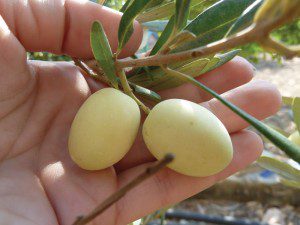 In the Mediterranean region there are two subspecies of Olive tree. These are the wild olive (O. europaea L. subsp. Oleaster) and the cultivated olive (O. europaea L. subsp. Sativa). Each subspecies has several cultivars selected for taste, size, disease resistance or other desirable qualities. There are 1,300 cultivars worldwide and Malta is no exception. The Maltija cultivar is probably the most popular Maltese cultivar and can give a high productivity. The Bidnija cultivar, which is believed to be the oldest Maltese olive cultivar (it is thought to date back to Roman times), produces oil of excellent quality rich in polyphenols (these have many health benefits), exhibits high tolerance to environmental stress such as salinity and drought, and demonstrates resistance to pathogens and pests such as the olive fruit fly. The Bajda variety produces a characteristic white drupe. Besides the native cultivars, there are a number of Maltese wild olives.
In the Mediterranean region there are two subspecies of Olive tree. These are the wild olive (O. europaea L. subsp. Oleaster) and the cultivated olive (O. europaea L. subsp. Sativa). Each subspecies has several cultivars selected for taste, size, disease resistance or other desirable qualities. There are 1,300 cultivars worldwide and Malta is no exception. The Maltija cultivar is probably the most popular Maltese cultivar and can give a high productivity. The Bidnija cultivar, which is believed to be the oldest Maltese olive cultivar (it is thought to date back to Roman times), produces oil of excellent quality rich in polyphenols (these have many health benefits), exhibits high tolerance to environmental stress such as salinity and drought, and demonstrates resistance to pathogens and pests such as the olive fruit fly. The Bajda variety produces a characteristic white drupe. Besides the native cultivars, there are a number of Maltese wild olives.
Renowned foreign varieties associated with high productivity tend to have a higher productivity than local cultivars. For this reason, local farmers find foreign varieties more convenient, leaving Malta at risk of forever losing its unique olives.
Till now revival efforts focus on artificial propagation and re-plantation. These trees are identified by their appearance. This is an inaccurate method since olive growth is influenced by environmental conditions.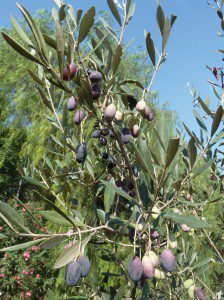
To develop a better way to identify local cultivars, Oriana Mazzitelli (supervised by Dr Marion Zammit Mangion) has focused on adopting a genetic approach. She also wanted to examine the genetic diversity of Maltese olive varieties. Mazzitelli compared the genetic patterns of local varieties to those generated by two commercial Italian (Carolea) and Tunisian varieties (Chemlali). The genetic analysis produced unique DNA profiles that can provide a more accurate means of identification than just looking at the plant.
The genetic variability between varieties was high. The Bidnija and Maltija stood out for their genetic uniqueness. The differences between local varieties suggest that, despite being allegedly native, the origins of the two are not directly linked. A number of DNA marker regions detected in the foreign cultivars and in the Maltese wild olive were undetected in the Maltese cultivars, suggesting that not all DNA markers are present and amplifiable in foreign varieties have been conserved in the Maltese cultivars. Mazzitelli’s work is an important first step to show that local varieties can be identified cheaply through DNA analysis. Without genetic identification, maintaining and cultivating local varieties would be near impossible—a case of genes for good olive oil.
This research is part of a Master of Science in Biochemistry at the Faculty of Medicine and Surgery, University of Malta. The research was funded by STEPS (Strategic Educational Pathways) scholarship which is part-financed by the EU’s European Social Fund (ESF) under Operational Programme II—Cohesion Policy 2007-2013, ‘Empowering People for More Jobs and a Better Quality of Life’.
Literature, Philosophy, and Games
Daniel Vella shares his passion for game research
A life studying life
Prof. Patrick J. Schembri lives for biology. His long career has brought him in touch with an endless list of creatures that includes fish, beautiful white coral, sharks, limpets, crabs, and ancient snails. Edward Duca met up with Schembri to find out more about the life around Malta.
I was nervous. I still remembered fumbling for excuses for handing in my assignment a few days late. Prof. Patrick J. Schembri’s stern gaze does not take excuses. This time I entered his office to learn about the wealth of research under this man’s belt. With over 150 refereed papers to his name I knew I would not leave disappointed.
In 1982 Schembri returned to Malta after a doctorate at the University of Glasgow and a post-doctorate in New Zealand.
‘In Scotland, I was working on animals that came from a depth of 40m and in New Zealand with animals that came from the whole span of the continental shelf and upper continental slope at depths down to about 900m. For that you need a research vessel, crew, collecting equipment, and so on. I came to Malta and there was nothing’, said Schembri. This did not stop him, like the animals he studies, he just adapted.
‘Nobody has looked at the ecology of shores in Malta before, so I decided to do that.’ And as simple as that, Schembri went from studying deep water animals to the near shore. The techniques and equipment needed are completely different — a diverse research background that must have helped him in his long career. After many years, Schembri returned to studying life in deep waters, invasive species, and many other things, but more on that later.
Back in the 80s the Internet simply did not exist locally so Schembri’s biggest problem was not equipment but sourcing academic journals. Every scientist needs to constantly read journals to keep up to date with the latest findings. It is essential for research inspiration, to see knowledge gaps that can be studied, to learn new techniques and knowledge, and to avoid repeating others’ research. Schembri, ever determined, went to great lengths to get the information he needed in order to research and publish.
‘Thanks to my mentors I was brought up with a culture of publishing.’ The renown of every scientist depends on the importance of the journals they publish in and how much they publish. Neither was a problem for Schembri. ‘I produced my first paper before I did my A levels. In the early 1970s, I improvised some apparatus to do experiments on something that you would [normally] need sophisticated equipment for, so rather than using a nitrogen chamber, I used a plastic bag to which I attached kitchen gloves, and it worked.’ After some encouragement from his tutor the paper was written as a note that was published in School Science Review. He also published around six papers from his Master’s degree. No small feat, I have not achieved this even after a Master’s degree and a Doctorate.
A Master of all Trades
The breath of his studies is stunning. With his students, Schembri has studied animals which have invaded Maltese waters. These include the nimble spray crab (Percnon gibbesi) and the non-indigenous Red Sea mussel (Brachidontes pharaonis), which, unlike all native mussels is forming mussel beds with thousands of individuals. He has studied the seabed’s ecosystems that happen to be vital to maintain fish stocks. He has even delved into Malta’s ecological past analysing samples from cores drilled in Malta’s coastal sediments studying sub-fossil molluscs to piece together the Island’s early history. These were only possible through collaboration with many scientists and a vast army of students.
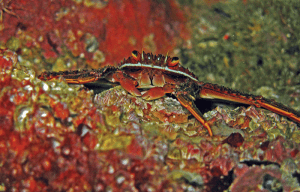
Percnon gibbesi
Photo by divemecressi, flickr
His collaborations have been essential. Schembri was contacted by Italian researcher Dr Marco Taviani to survey Malta’s deep seas. Taviani has access to the multi-million research vessel Urania. The 61.3m ship has on-board laboratories for geological, chemical, radiological, geophysical, and biological research. To make it in Malta, ‘if you don’t have enough resources you have to improvise and collaborate, especially with overseas researchers who do have the resources. And it worked’.
Schembri has gone further than just making it work. He has flourished. His strategy involves participating in EU funded projects (to bring in the money) while keeping very ambitious long-term projects running in the background on a shoestring. The only problem is that for ‘all the EU projects, the agenda is set internationally. While [for local projects] the funds are minimal, I get a few hundreds a year. But I am free to study what is interesting and important for Malta.’
Managing Fish
BENESPEFISH is one of his locally funded projects. ‘I want to find out what kind of habitats we (Malta) have and how fish interact with them.’ By studying what fish eat and where that food grows, by seeing the nursery grounds and spawning areas of the fish, by researching how the impact of fishing techniques affects the sea floor that ends up damaging the ecosystem. For example, in collaboration with the Government’s Fisheries Agency, students under Schembri’s supervision studied the effect of a type of fishing technique called otter trawling. They discovered that it can adversely change the benthic (seabed) ecosystem and that the trawling should be done in corridors, with spaces between them to allow the recuperation of the seabed, and therefore the dependent fish stocks. This will help fish stocks recuperate and fishermen to retain their livelihood.
“For some strange reason, beforehand fish were one thing and the rest of the sea was something else”
The above is called the ecosystem approach to fisheries management. Back in the early 2000s ‘Matthew Camilleri from the Fisheries and Aquacultures Department got involved in a FAO (Food and Agriculture Organisation) project called MEDSUDMED,’ that was pushing for this approach. ‘So he asked if I could help out with the ecological aspect. […] Ecologists entered the picture because in this approach fish started being looked at as part of the ecosystem. For some strange reason, previously fish were one thing and the rest of the sea was something else’ — a clear reason for fisheries scientists and marine biologists to work together to be able to give the right scientific advice to the Government.
The BENESPEFISH project hinges on a healthy relationship with the Government. The Government Fisheries Agency commissions the MEDITS trawl survey to monitor the health of fish stocks, which are mandatory for all EU member states that border the Mediterranean. These surveys need to ‘follow a strict protocol’, perfect for science. However, the survey ‘is limited to about 40 species. They still get everything else such as benthic organisms [that live on the sea bed] that they used to just throw overboard. So I said to them, okay why don’t you keep it, give it to me, I work on it, then I give you the results. […] If I had to hire a fishing trawler and go out myself for 14 days it would cost me around €190,000, crews and everything. Instead, by collaborating, we get this data at a low cost. All I need to pay for is for insurance, fixatives, sample containers, and a research assistant to collect the samples. So that’s what the University funds, it funds the research assistant and materials. […] So you [the Government] get information which you would not normally get because you are not a research institution.’ Clever and it worked.
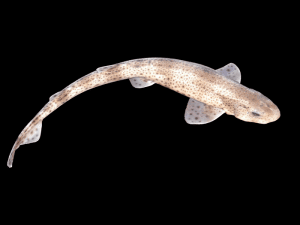
These discards are valuable to find out about the ecology of the fish in our seas. ‘They were going to get rid of a few hundred sharks (the small-spotted catshark, Scyliorhinus canicula) […], so I got them and one of my students analysed their stomach contents which told us a great deal about what the fish feed on and also where they feed. […] They feed on fish but also on the benthos, the bottom material.’ From 532 stomachs sampled, over half were eating teleosts (a group of bony fishes) and nearly one fifth were eating crustaceans, with even some cannibalism. Male and female catsharks had different diets. To keep catshark populations healthy these food sources need to be maintained. The seabed is vital.
These MEDITS surveys have led to some surprising discoveries. During a survey one of Schembri’s students picked up a piece of white coral which she brought back to be identified in the lab. It turned out to be the deep water coral Lophelia pertusa that builds reefs. Schembri still had this piece and showed it to me. As I picked up this brilliant white coral he told me, ‘this is just a piece of a much larger structure. You can see the remains of some the individual animals [it is a colonial species made of many individuals], the cup-like structures with grooves.’ It is such a different species — out of this world. Schembri and his group reported finding this coral around Malta that attracted Marco Taviani (Institute of Marine Sciences, National Research Council of Italy), who was a colleague of Schembri, to organise a research cruise. Using the Italian research vessel the Urania they explored Maltese deep waters. This was the first of three such cruises that Schembri’s research group were invited to participate in. During one of these cruises they found other species of corals including the endangered red coral (Corallium rubrum), exploited since antiquity to make jewellery. They saw it at depths never seen before, around 600–800m, which is two to three times deeper than previously. When studied, this deep water population was found to be genetically isolated from others, probably because the different populations were not breeding amongst each other.
Malta’s Coast
When Schembri first came back to Malta he started working on its shores. But our coasts are not just beaches and cliffs. ‘Inland the coastal area extends as far as sea spray carries, since this renders the soil saline and therefore only adapted plants can thrive. […] Offshore, the coastal area extends to depths of 150–200m as material from the land, like sediment, still finds its way to the seabed even at those depths.’ That is a huge area for a researcher to cover, but Schembri wants to record all its habitats, obviously with a lot of help.
Enter the project Faunistics and Ecology of the Maltese Islands (FEMI), ‘the aim is to have an inventory of what we’ve got. […] I want to understand what habitats we have and which species live there.’ To cope with such a massive project, Schembri splits it up into bite-size research questions that his students can tackle over a few months (or longer if it is a Master’s or a Doctorate project). ‘The results of each small project contribute to the whole. […] By now I would say that over the years the number of people who have contributed to the project must be at least a hundred, although it is usually around six at any one time.’ Many of these student projects lead to research publications coming out from the University of Malta’s Department of Biology.
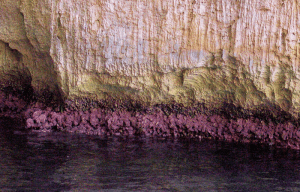
One of the most important things for the FEMI project is to figure out the state of our current environment. By knowing how things are we can tell how they are altered by future change. Back in 1998 Schembri, Dr Mark Dimech and Dr Joseph A. Borg studied how fish farms in St Paul’s Bay were affecting the ecosystem underneath. The nutrients and waste were reducing the biodiversity immediately under the cages to around a range of 30m. In between 50–170m, the fish farm unexpectedly increased the number and diversity of invertebrates. Without knowing the species normally growing in sea grass meadows this would be impossible.
By studying Malta’s coast and offshore waters for so long, Schembri can say which areas and habitats around Malta have the greatest diversity in species and which are at risk. These tend to overlap; on land the sand dunes and saline marshlands need to be preserved, while at sea it is the seagrass beds, maerl and other rhodolith bottoms, and any form of natural reef that need conservation. Such long term studies are essential to know how humans are impacting the environment and to better manage Malta’s living resources.
A Warming Mediterranean
The world is changing. The actions of human beings are warming the planet much faster than just natural processes. ‘The Mediterranean Sea is warming up. The sea is also receiving less rainfall and less terrestrial runoff, which is making the sea more saline [salty]. All of these phenomena are leading to many changes occurring at the same time. The first thing that you are getting is that native species, which were limited to the warmer parts of the Mediterranean, can extend their range to the colder parts, so southern species are moving northwards. It means that the cold-loving species cannot move further north, because we are completely surrounded by land. So populations of cold water species are becoming rarer and less distributed and if things go on like that some might become extinct because they cannot escape. In the Atlantic they just move further north, but not here, they cannot do that.’
“A warming sea is one main reason why new alien and sometimes invasive species are being found in Malta all of the time”
Loss of species is not the only thing a warming sea causes. ‘The second thing observed is that species from the East Mediterranean, which is the warmest and most saline part of the Mediterranean [and includes many species that invaded from the Red Sea via the Suez Canal], are moving westwards. Species which are warm water Atlantic species enter the Mediterranean and are now moving eastwards.’ This means that these species are all passing by Malta as they disperse, making the island an ideal monitoring station to observe a changing Mediterranean.
A warming sea is one main reason why new alien and sometimes invasive species are being found in Malta all of the time. These species are making great leaps. Dr Julian Evans, Dr Joseph Borg, and Schembri have recently (2013) found for the first time the Red Sea sea squirt Herdmania momus in Malta. This record is 1,300km further west than ever before. This sea squirt came through the Suez canal, established itself in the Levantine Sea off Lebanon, and was last observed around Greece and Turkey. It is not the only foreigner that has established itself in our waters.
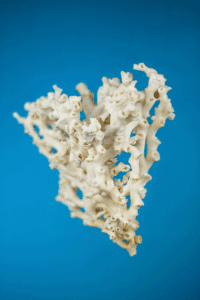
Schembri and one of his collaborators Dr Marija Sciberras saw the nimble spray crab (Percnon gibbesi) all along Maltese shores. This crab is an Atlantic species that entered the Mediterranean through the Strait of Gibraltar in the late 1990s. When they found it in Malta they did not just collect it — they studied it. They found that this shallow water species grows ‘up to a depth of 3m, in other parts of the Mediterranean they have found it down to depths of 10m. It needs a habitat of cobbles or stones, it does not live on bare rock. [In Malta this means] that you find it more towards the north rather than the south, because the coast slopes down to the north and you’ve got many more opportunities for this sort of habitat while the south is mainly cliffs.’ The local shore crab (Pachygrapsus marmoratus) also beats this invader. They saw that the local crabs are much more aggressive than the invader. The nimble spray crab has mostly occupied a niche different from that of local shore crabs.
When we hear the word invader we do not imagine a mostly plant-eating crab sneaking into a new niche while the local omnivorous crab remains reigning supreme; but an invasive species ‘simply means that it spreads very quickly. [To understand] what the effect on the ecosystem is requires many years of study. We have many invaders. Another one, which is even more invasive, is a seaweed — an algae (Caulerpa racemosa) — this is now found everywhere. What does it do? What effect does it have on the local ecosystem? I don’t know, nobody does.’ This is why we need to invest more into scientific research over many years. You cannot figure out how a species is acting
overnight.
Schembri has been studying Malta’s ecology for decades. This long-term knowledge is vital to see slow trends like a warming Mediterranean, climate change, or habitat loss. When I asked him about the changes affecting Malta and Gozo, he replied in a sombre voice ‘I’ve seen a lot of change. In terms of change of habitat, apart from places which have been developed, not much has changed on the open coast. What has changed are the characteristics of the community. For example, previously you used to find large limpets, now you’ll find small limpets. That sort of thing. You haven’t lost a limpet or had a complete change in the ecosystem, but there have been changes nonetheless.’
In some places, especially sheltered areas, things have changed drastically. For his Master’s degree, Schembri collected specimen from Marsaxlokk Bay. This was many years before the development of the Freeport and Delimara power station. When he had a look at it after these developments the species he studied had vanished. ‘The bay has changed and when they started dredging it was even worse because a lot of the sea grasses disappeared. That bay was full of sea grasses before.’ Schembri does not think they will return anytime soon. Loss of sea grasses are even eroding the shore. ‘The sea grass was acting as a buffer to the waves, although it could also be because people have been building breakwaters and things which would change the current patterns which would also cause erosion. These things are complicated and without studying them it is difficult to know and nobody has looked’ — another reason for more researchers and funds being needed.
Marsaxlokk is not the only place. Especially since the 1990s the Maltese coast has been heavily built up, with developments sprouting in many picturesque areas like Armier. Dealing with this development has become a political issue, rather than seeing the consequences from a scientific lens.
Schembri’s view on this change is a bit peculiar to me. When I referred to the changes in Marsaxlokk Bay as ecological devastation he replied saying, ‘I don’t talk about ecological devastation, because what life does is that if the environment changes certain things disappear and other things take their place. Saying it is devastation is a human emotion. Scientifically it’s not what happens.’ Schembri was speaking impersonally from an ecological perspective. I find it hard to see the complete loss of a species or beautiful area because of human progress in this way. If humans are doing the destruction, humans can stop it or reduce the problem.
Ecologists for Tomorrow
Ecologists like Schembri are vital to know the changes taking place around our islands. Without monitoring our land and seas we cannot know how to preserve them so everyone can enjoy them. Nature should be for everyone to enjoy and experience.
Malta’s situation has definitely improved. ‘We have a huge marine protected area going all the way from Qala in Gozo to Portomaso in St Julians to protect all the seagrass meadows there. How are we managing it? We’re not. It’s a line on a map, but it is a first step’ since if anyone wants to develop the area the development’s impact on the ecology needs to be rigorously studied. Unfortunately, no one knows if the sea grasses are doing well or not. The problem is that the area is huge. ‘You don’t try to keep track of every single square metre of sea grass but at least you keep track of some of them. You establish a monitoring programme, the Government is obliged to do it having declared a marine protected area in terms of the Habitats Directive, and some monitoring is being done but there is no management plan.’ The problem is that Malta is an island with limited resources and 10 people abroad would perform one person’s job here. Government needs to give the environment and science more importance.
Schembri’s flexible approach to research is powerful. He makes it work despite the odds, but I do wonder how much more we would know about Malta’s natural wealth if there were many more researchers studying the Maltese environment and if they had better support. There are other researchers apart from Schembri, but they are few. For such a serious man, serious investment in research would surely make him, and future generations, smile.
Find out more:
-
Sciberras, M. & Schembri, P.J. (2008) Biology and interspecific interactions of the alien crab Percnon gibbesi (H. Milne-Edwards, 1853) in the Maltese Islands. Marine Biology Research 4: 321-332.
-
Costantini, F., Taviani, M., Remia, A., Pintus, E., Schembri, P.J. & Abbiati, M. (2010) Deep-water Corallium rubrum (L., 1758) from the Mediterranean Sea: preliminary genetic characterisation. Marine Ecology 31: 261-269.
-
Gravino, F., Dimech, M. & Schembri, P.J. (2010) Feeding habits of the small-spotted catshark Scyliorhinus canicula (l., 1758) in the Central Mediterranean. Rapport du Congrès de la Commission Internationale pour l’Exploration Scientifique de la Mer Méditerranée 39: 538.
-
Evans, J., Borg, J.A. & Schembri P.J. (2013) First record of Herdmania momus (Ascidiacea: Pyuridae) from the central Mediterranean Sea. Marine Biodiversity Records 6: e134; 4pp. [Online. DOI: 10.1017/S1755267213001127]
How do you cook the perfect steak?
Fillet is the best cut. Trust me. It’s worth the money.
Use molecular gastronomy to take advantage of decades of researching how meat changes with heat. Science indicates that the best cooking temperature is around 55˚C, and definitely not above 60˚C. At a high temperature, myofibrillar (hold 80% of water) and collagen (hold beef together) proteins shrink. Shrinking leads to water loss. In the water lies the flavour.
To cook the fillet use a technique called sous vide. It involves vacuum wrapping the beef and keeping it at 55˚C in a water bath for 24–72 hours. This breaks down the proteins without over heating. The beef becomes tender but retains flavour and juiciness.
Take the beef out. It will look unpalatable. Quickly fry it on high heat on both sides to brown it. The high heat triggers the reduction of proteins or the Maillard reaction. Enjoy with a glass of your favourite red.
Decoding Language
Maltese needs to be saved from digital extinction. Dr Albert Gatt, Prof. Gordon Pace, and Mike Rosner write about their work making digital tools for Maltese, interpretting legalese, and making a Maltese-speaking robot
In 2011 an IBM computer called Watson made the headlines after it won an American primetime television quiz called Jeopardy. Over three episodes the computer trounced two human contestants and won a million dollars.
Jeopardy taps into general world knowledge, with contestants being presented with ‘answers’ to which they have to find the right questions. For instance, one of the answers, in the category “Dialling for Dialects”, was: While Maltese borrows many words from Italian, it developed from a dialect of this Semitic language. To which Watson correctly replied with: What is Arabic?
Watson is a good example of state of the art technology that can perform intelligent data mining, sifting through huge databases of information to identify relevant nuggets. It manages to do so very efficiently by exploiting a grid architecture, which is a design that allows it to harness the power of several computer processors working in tandem.
“Maltese has been described as a language in danger of ‘digital extinction’”
This ability alone would not have been enough for it to win an American TV show watched by millions. Watson was so appealing because it used English as an American would.
Consider what it takes for a machine to understand the above query about Maltese. The TV presenter’s voice would cause the air to vibrate and hit the machine’s microphones. If Watson were human, the vibrations would jiggle the hairs inside his ear so that the brain would then chop up the component sounds and analyse them into words extremely rapidly. The problem for a computer is that there is more to language than just sounds and words. A human listener would need to do much more. For example, to figure out that ‘it’ in the question probably refers to ‘Maltese’ (rather than, say, ‘Italian’, which is possible though unlikely in this context). They would also need to figure out that ‘borrow’ is being used differently than when one says borrowing one’s sister’s car. After all, Maltese did not borrow words from Italian on a short-term basis. Clearly the correct interpretation of ‘borrow’ depends on the listener having identified the intended meaning of ‘Maltese’, namely, that it is a language. Watson was equipped with Automatic Speech Recognition technology to do exactly that.
To understand language any listener needs to go beyond mere sound. There are meanings and structures throughout all language levels. A human listener needs to go through them all before saying that they understood the message.
Watson was not just good at understanding; he was pretty good at speaking too. His answers were formulated in a crisp male voice that sounded quite natural, an excellent example of Text-to-Speech synthesis technology. In a fully-fledged human or machine communicating system, going from text to speech requires formulating the text of the message. The process could be thought of as the reverse of understanding, involving much the same levels of linguistic processing.
Machine: say ‘hello’ to Human
The above processes are all classified as Human Language Technology, which can be found in many devices. Human Language Technology can be found everywhere from Siri or Google Now in smart phones to a word processing program that can spell, check grammar, or translate.
Human-machine interaction relies on language to become seamless. The challenge for companies and universities is that, unlike artificial languages (such as those used to program computers or those developed by mathematicians), human languages are riddled with ambiguity. Many words and sentences have multiple meanings and the intended sense often depends on context and on our knowledge of the world. A second problem is that we do not all speak the same language.
Breaking through Maltese
Maltese has been described as a language in danger of ‘digital extinction’. This was the conclusion of a report by META-NET, a European consortium of research centres focusing on language technology. The main problem is a lack of Human Language Technology — resources like word processing programs that can correctly recognise Maltese.
Designing an intelligent computer system with a language ability is far easier in some languages than it is in others. English was the main language in which most of these technologies were developed. Since researchers can combine these ready-made software components instead of developing them themselves, it allows them to focus on larger challenges, such as winning a million dollars on a TV program. In the case of smaller languages, like Maltese, the basic building blocks are still being assembled.
Perhaps the most fundamental building block for any language system is linguistic data in a form that can be processed automatically by a machine. In Human Language Technology, the first step is usually to acquire a corpus, a large repository of text or speech, in the form of books, articles, recordings, or anything else that happens to be available in the correct form. Such repositories are exploited using machine-learning techniques, to help systems grasp how the language is typically used. To return to the Jeopardy example, there are now programs that can resolve pronouns such as ‘it’ to identify their antecedents, the element to which they refer. The program should identify that ‘it’ refers to Maltese.
For the Maltese language, researchers have developed a large text/speech repository, electronic lexicons (language’s inventory of its basic units of meaning), and related tools to analyse the language (available for free). Automatic tools exist to annotate this text with basic grammatical and structural information. These tools require a lot of manual work however, once in place, they allow for the development of sophisticated programs. The rest of this article will analyse some of the on-going research using these basic building blocks.
From Legalese to Pets
Many professions benefit from automating tasks using computers. Lawyers and notaries are the next professionals that might benefit from an ongoing project at the University of Malta. These experts draft contracts on a daily basis. For them, machine support is still largely limited to word processing, spell checking, and email services, with no support for a deeper analysis of the contracts they write and the identification of their potential legal consequences, partly through their interaction with other laws.
Contracts suffer from the same challenges when developing Human Language Technology resources. A saving grace is that they are written in ‘legalese’ that lessens some problems. Technology has advanced enough to allow the development of tools that analyse a text to enable extraction of information about the basic elements of contracts, leaving the professional free to analyse the deeper meaning of these contracts.
Deeper analysis is another big challenge in contract analysis. It is not restricted to just identifying the core ‘meaning’ or message, but needs to account the underlying reasoning behind legal norms. Such reasoning is different from traditional logic, since it talks about how things should be as opposed to how they are. Formal logical reasoning has a long history, but researchers are still trying to identify how one can think precisely about norms which affect definitions. Misunderstood definitions can land a person in jail.
Consider the following problem. What if a country legislates that: ‘Every year, every person must hand in Form A on 1st January, and Form B on 2nd January, unless stopped by officials.’ Exactly at midnight between the 1st and 2nd of January the police arrest John for not having handed in Form A. He is kept under arrest until the following day, when his case is heard in court. The prosecuting lawyer argues that John should be found guilty because, by not handing in Form A on 1st January he has violated the law. The defendant’s lawyer argues that, since John was under arrest throughout the 2nd of January he was being stopped by officials from handing in Form B, absolving him of part of his legal obligation. Hence, he is innocent. Who is right? If we were to analyse the text of the law logically, which version should be adopted? The logical reasoning behind legal documents can be complicated, which is precisely why tools are needed to support lawyers and notaries who draft such texts.
Figuring out legal documents might seem very different to what Watson was coping with. But there is an important link: both involve understanding natural language (normal every day language) for something, be it computer, robot, or software, to do something specific. Analysing contracts is different because the knowledge required involves reasoning. So we are trying to wed recent advances in Human Language Technology with advances in formal logical reasoning.
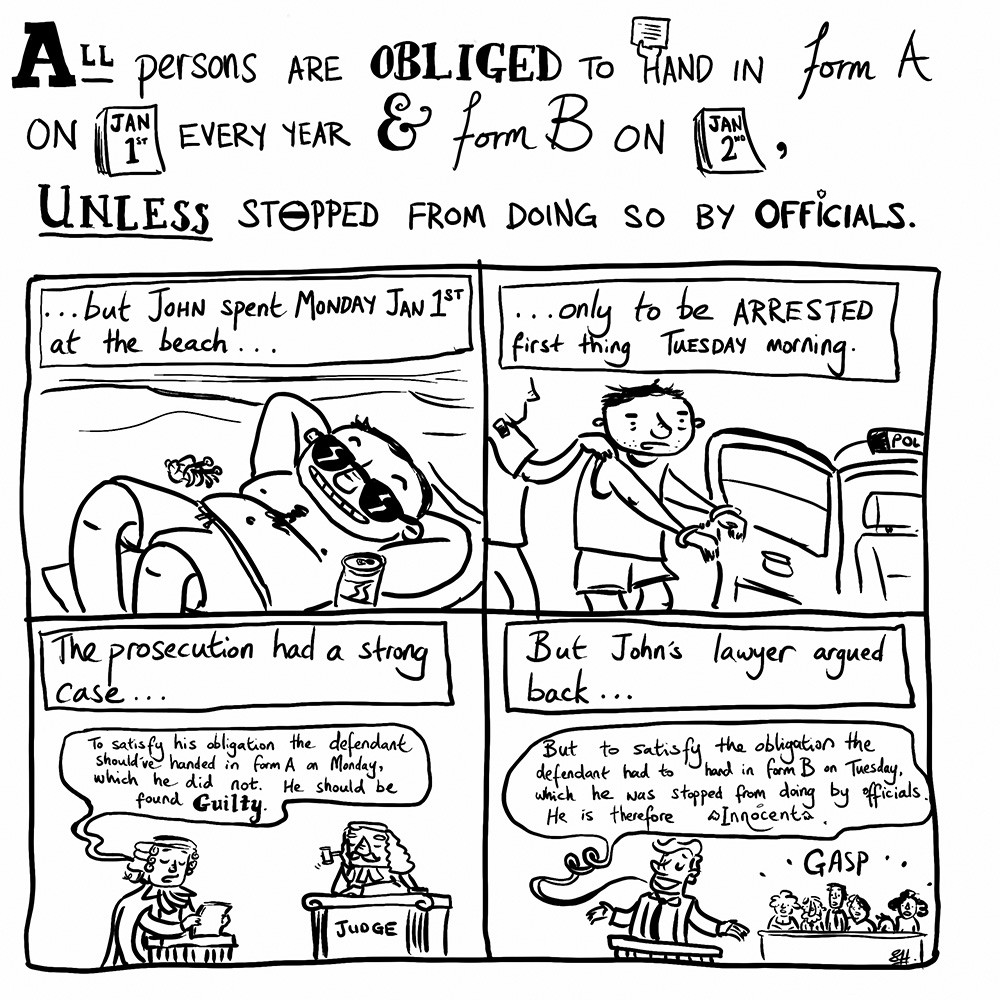
Contract drafting can be supported in many ways, from a simple cross-referencing facility, enabling an author to identify links between a contract and existing laws, to identifying conflicts within the legal text. Since contracts are written in a natural language, linguistic analysis is vital to properly analyse a text. For example in a rent contract when making a clause about keeping dogs there would need to be a cross-reference to legislation about pet ownership.
We (the authors) are developing tools that integrate with word processors to help lawyers or notaries draft contracts. Results are presented as recommendations rather than automated changes, keeping the lawyer or notary in control.
Robots ’R’ Us
So far we have only discussed how language is analysed and produced. Of course, humans are not simply language-producing engines; a large amount of human communication involves body language. We use gestures to enhance communication — for example, to point to things or mime actions as we speak — and facial expressions to show emotions. Watson may be very clever indeed, but is still a disembodied voice. Imagine taking it home to meet the parents.
“Robby the Robot from the 1956 film Forbidden Planet, refused to obey a human’s orders”
Robotics is forging strong links with Human Language Technology. Robots can provide bodies for disembodied sounds allowing them to communicate in a more human-like manner.
Robots have captured the public imagination since the beginning of science fiction. For example, Robby the Robot from the 1956 film Forbidden Planet, refused to obey a human’s orders, a key plot element. He disobeyed because they conflicted with ‘the three laws of robotics’, as laid down by Isaac Asimov in 1942. These imaginary robots look somewhat human-shaped and are not only anthropomorphic, but they think and even make value judgements.
Actual robots tend to be more mundane. Industry uses them to cut costs and improve reliability. For example, the Unimate Puma, which was designed in 1963, is a robotic arm used by General Motors to assemble cars.
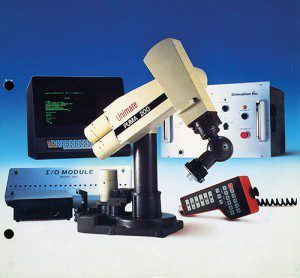
The Puma became popular because of its programmable memory, which allowed quick and cheap reconfiguration to handle different tasks. But the basic design was inflexible to unanticipated changes inevitably ending in failure. Current research is closing the gap between Robby and Puma.
Opinions may be divided on the exact nature of robots, but three main qualities define a robot: one, a physical body; two, capable of complex, autonomous actions; and three, able to communicate. Very roughly, advances in robotics push along these three highly intertwined axes.
At the UoM we are working on research that pushes forward all three, though it might take some time before we construct a Robby 2. We are developing languages for communicating with robots that are natural for humans to use, but are not as complex as natural languages like Maltese. Naturalness is a hard notion to pin down. But we can judge that one thing is more or less natural than another. For example, the language of logic is highly unnatural, while using a restricted form of Maltese would be more natural. It could be restricted in its vocabulary and grammar to make it easier for a robot to handle.
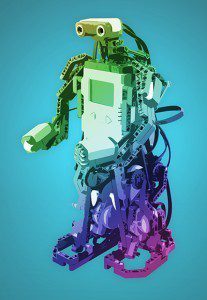 Take the language of a Lego EV3 Mindstorms robot and imagine a three-instruction program. The first would be to start its motors, the second to wait until light intensity drops to a specific amount, the third to stop. The reference to light intensity is not a natural way to communicate information to a robot. When we talk to people we are not expected to understand how the way we put our spoken words relates to their hardware. The program is telling the robot to: move forward until you reach a black line. Unlike the literal translation, this more natural version employs concepts at a much higher level and hence is accessible to anybody with a grasp of English.
Take the language of a Lego EV3 Mindstorms robot and imagine a three-instruction program. The first would be to start its motors, the second to wait until light intensity drops to a specific amount, the third to stop. The reference to light intensity is not a natural way to communicate information to a robot. When we talk to people we are not expected to understand how the way we put our spoken words relates to their hardware. The program is telling the robot to: move forward until you reach a black line. Unlike the literal translation, this more natural version employs concepts at a much higher level and hence is accessible to anybody with a grasp of English.
The first step is to develop programs that translate commands spoken by people into underlying machine instructions understood by robots. These commands will typically describe complex physical actions that are carried out in physical space. Robots need to be equipped with the linguistic abilities necessary to understand these commands, so that we can tell a robot something like ‘when you reach the door near the table go through it’.
To develop a robot that can understand this command a team with a diverse skillset is needed. Language, translation, the robot’s design and movement, ability to move and AI (Artificial Intelligence) all need to work together. The robot must turn language into action. It must know that it needs to go through the door, not through the table, and that it should first perceive the door and then move through it. A problem arises if the door is closed so the robot must know what a door is used for, how to open and close it, and what the consequences are. For this it needs reasoning ability and the necessary physical coordination. Opening a door might seem simple, but it involves complex hand movements and just the right grip. Robots need to achieve complex behaviours and movements to operate in the real world.
The point is that a robot that can understand these commands is very different to the Puma. To build it we must first solve the problem of understanding the part of natural language dealing with spatially located tasks. In so doing the robot becomes a little bit more human.
A longer-term aim is to engage the robot in two-way conversation and have it report on its observations — as Princess Leia did with RT-D2 in Star Wars, if RT-D2 could speak.

Language for the World
Human Language Technologies are already changing the world. From automated announcements at airports, to smartphones that can speak back to us, to automatic translation on demand. Human Language Technologies help humans interact with machines and with each other. But the revolution has only just begun. We are beginning to see programs that link language with reasoning, and as robots become mentally and physically more adept the need to talk with them as partners will become ever more urgent. There are still a lot of hurdles to overcome.
To make the right advances, language experts will need to work with engineers and ICT experts. Then having won another million bucks on a TV show, a future Watson will get up, shake the host’s hand, and maybe give a cheeky wink to the camera.

